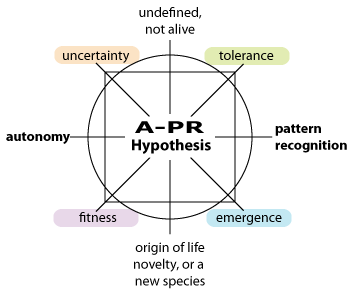
home | links | compass

Subjectivity–Objectivity
complementarity needed for
collaborative intelligence
Subjectivity – our diverse
POVs and interpretations
Objectivity – the facts of
the world we interpret
LINKS
References
von Ahn on Human
Computation
AI Conferences
Animating Time Data
Climate Collab
Darwin papers
EO Wilson Foundation
Gapminder
Geo-tagger's World Atlas
Gordon Lab
Innovation Networks
IRIDIA
Kelly - Hivemind
Kirschner Lab
London Open Street Map
Los Alamos – Symbiotic
Intelligence
Microbes–Mind Forum
MIT Center for
Collective Intelligence
Planet Innovation
Recommender Systems
SIGCHI
SIGEVO
SIGGRAPH
Turner Fieldwork
Vinge on Singularity
Wall Street Journal
BOOKS
![]()
Hansen, Schneiderman,
Smith – Analyzing Social
Networks - Node XL
![]()
Surowieki_
Wisdom of Crowds
![]()
J Fodor & M P
What Darwin Got Wrong
![]()
E Jablonka & M Lamb
Evolution in 4D
![]()
M Kirschner & J Gerhart –
Plausibility of Life
![]()
J Scott Turner
Tinkerer's Accomplice
![]()
J Scott Turner
The Extended Organism
![]()
MJ West-Eberhard –
Developmental
Plasticity & Evolution
Collaborative Autonomy |
• autonomy of individuals as unique participants in their ecosystems, Whereas we tend to assume individuality is the foundation for competition, collaboration implies suppressing individuality to an agreed consensus. A paradigm shift is needed to understand that exactly the opposite is true. Leading evolutionary theorists have noted the central role that individuality plays in driving evolutionary advance toward increased functional effectiveness. Differences between individuals, and collaboration among individuals, are prerequisites for evolution. Sir Charles Sherrington's classic statement: “Life is always and has always been individual. That is related to its mode of generation. There is here no question of a ‘universal’ because any attempt at definition of life must start out with the concept of the ‘individual,’ otherwise it would not be life." Harvard evolutionary biologist Ernst Mayr (1904 – 2005) noted that competition among individuals would be irrelevant if individuals were typologically identical. Individual differences are a prerequisite for evolution. Contemporary biologist Leo Buss at Yale University formulated his hypothesis that individuality evolves through the collaboration of components into a higher, more complex individual. Coordinated collaboration precedes and enables individual specialization. Evolutionary biology has underscored the importance of the individual for evolution, as highlighted by Louis Menand: "Once our attention is redirected to the individual, we need another way of making generalizations. We are no longer interested in the conformity of an individual to an ideal type; we are now interested in the relation of an individual to the other individuals with which it interacts. To generalize about groups of interacting individuals, we need to drop the language of types and essences, which is prescriptive (telling us what finches should be), and adopt the language of statistics and probability, which is predictive (telling us what the average finch, under specified conditions, is likely to do). Relations will be more important than categories; functions, which are variable, will be more important than purposes; transitions will be more important than boundaries; sequences will be more important than hierarchies." • Automated sensing activities |
||
|
||
 Diagram © Zann Gill 2011 |
Autonomy. Individual contributors collaborate, maintaining their diversity of roles and priorities as they apply unique skills in a problem-solving process. Individuals are not homogenized, as in consensus-driven processes, nor equalized through quantitative data processing, as in collective intelligence. Pattern Recognition. Unique capacities for pattern recognition and interpretation characterize living systems and enable them to choose appropriate (or not) actions in context, driving evolution toward increased functional effectiveness. The A-PR capacity occurs in iterative learning, self-improving systems and is the most powerful way that artificial systems can mimic life, which discriminates on its own behalf, bootstrapping itself toward improved functionality by its choices. |
|
|
||
|
||